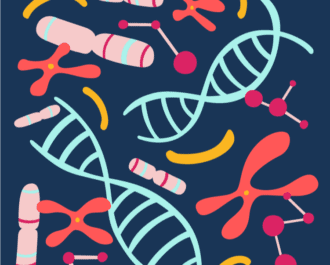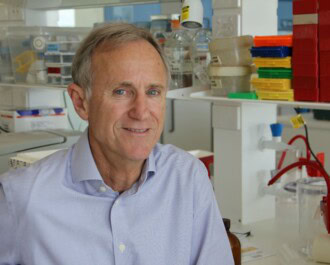
CRISPR-Cas9 (henceforth referred to as “CRISPR”) is a new gene editing technology that has the potential to treat a wide range of diseases including breast cancer. In biology, gene expression is the process where information stored in our DNA (genes) is converted to a functional product (e.g. a protein). In breast cancer, abnormal gene expression can lead to cells making too much (or too little) of a protein, which may lead to uncontrolled cell growth. CRISPR has the ability to correct abnormal gene expression, thereby changing the levels of individual proteins in cells, and changing how cells function. Currently, scientists are exploring whether CRISPR can be used as a novel approach to treat breast cancers.
CRISPR technology is still in the relatively early stages of development, and has not been tested yet in a clinical trial for breast cancer. Before CRISPR can be used clinically, scientists must show it is possible to safely and effectively deliver the treatment into the target cells. Current methods used for delivering CRISPR can have undesirable effects to other tissues and cells, or can be toxic to the patient.
Recently and for the first time, researchers in Perth developed a completely synthetic delivery system which can safely transport CRISPR to the targeted breast cancer cells. A research team from the Harry Perkins Institute of Medical Research, headed by NBCF-funded Associate Professor Pilar Blancafort (and including NBCF-funded researchers Dr Anabel Sorolla and Dr Nicole Smith), developed the specialised polymer system. The team recently published their groundbreaking findings in the journal Chemical Science.
In the study, the synthetic polymer system delivered the CRISPR, which preferentially homed to breast cancer cells and successfully restored the expression of two genes, called MASPIN and CCN6. Typically in breast cancer, these genes are not as active as they should be (i.e. their gene expression is reduced). Using their new delivery system, the team were able to “switch-on” (or increase the gene expression) of these genes. In a mouse model of breast cancer, this led to reduced tumour growth.
Whilst this is exciting progress, it will still be some time before CRISPR will be available to patients.
“Further studies are required before we can use this technology clinically in humans,” explained Associate Professor Pilar Blancafort. “However, we have now shown for the first time that a completely synthetic (and targeted) delivery strategy for CRISPR can be used in a mouse model of breast cancer. Importantly, there was no observable toxicity. We are excited about the future potential of this system to help reduce tumour growth in women with breast cancer.

Associate Professor Pilar Blancafort
More News Articles
View all News


